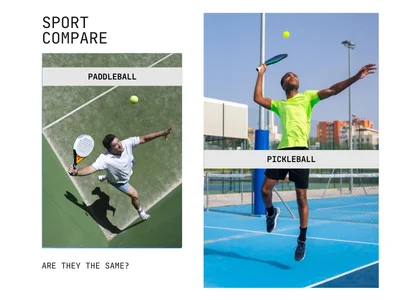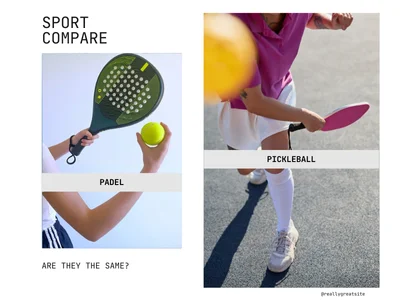Two games often stand out in racquet sports due to their popularity and unique characteristics:pickleball vs tennis.
But which one really takes the trophy? Is it tennis, with its powerful serves and long rallies? Or pickleball, with its quick action and strategic plays?
This article aims to delve into a comparative analysis of these two sports, providing an in-depth look at their origins, rules, equipment, and the skills required to play them.
Overview
Pickleball
This sport is a dynamic blend of elements of tennis, badminton, and table tennis. It’s played on a flat surface with paddles that are shorter than those used in tennis and a plastic ball with holes in it. The game can be played one-on-one or in teams of two, and it can be enjoyed both indoors and outdoors.
The birthplace of Pickleball is the United States, where it was invented in 1965. It saw a surge in popularity in the early 21st century.
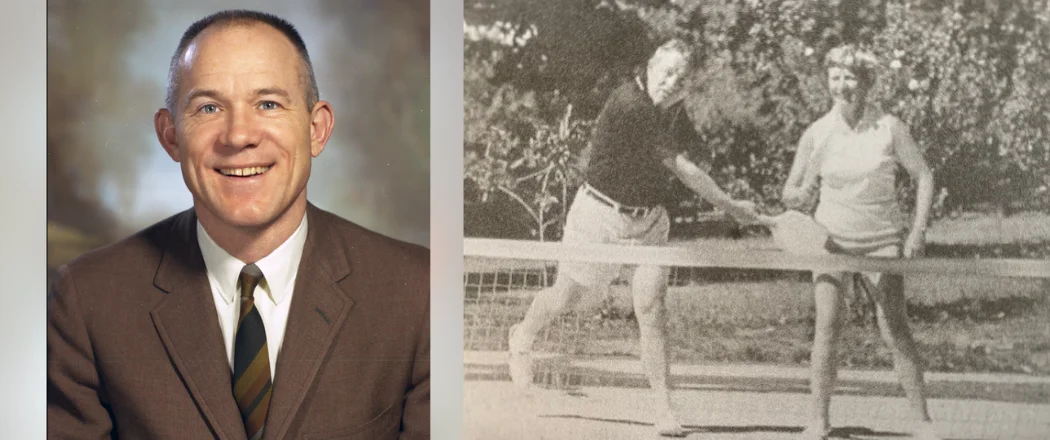
For more information, the game was born in the summer house of Joel Pritchard, who later became a U.S. Congressman and the lieutenant governor of Washington.
The name “Pickleball” was coined by Joan Pritchard, Joel’s wife, who said the game reminded her of a pickleboat in crew racing, where the remaining oarsmen from other boats were chosen.
Tennis
Tennis is a sport where two players or two teams of two players use rackets to hit a ball over a net into the opponent’s court. The ball must meet specific size, weight, and bounce criteria.
Points are scored when the opponent fails to return the ball within the boundaries of the court.
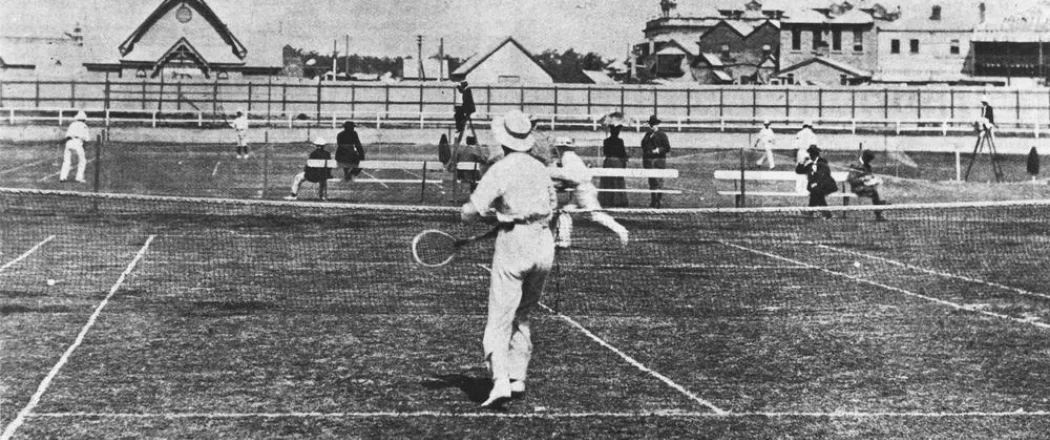
Britannica states that the game’s roots can be traced back to a French handball game from the 12th to 13th century called “jeu de paume,” which means “game of the palm.”
This game evolved into a more complex indoor racket-and-ball game known as real tennis. It wasn’t until the 16th century that the game became known as tennis. Today, millions of people enjoy tennis at clubs and public courts worldwide.
What Are The Differences Between Pickleball Vs Tennis?
| Key Difference | Tennis | Pickleball |
|---|---|---|
| Rule | Serve must land in the service box; second serve allowed for faults | Underhand serve below the waist; server continues until fault, then partner serves |
| Scoring | Points: 15, 30, 40, game; must win by 2 points if tied at 40-40 (deuce) | Played to 11 points, win by 2; only serving team scores |
| Court Size | Larger: 78 ft x 36 ft for singles, 60 ft x 120 ft for doubles | Smaller: 20 ft x 44 ft |
| Equipment | Racket (stringed), rubber/felt balls, net height 42 inches at posts | Paddle (solid face), plastic balls with holes, net height 36 inches at posts |
| Calories Burned | Higher: 573 calories/hour for singles, 422 for doubles (150 lb person) | Lower: 357 calories/hour for singles, 265 for doubles (150 lb person) |
| Noise Level | Quieter: around 45 dB | Louder: around 55 dB |
| Injury Types | Higher risk for lower back, hip, Achilles tendon injuries | Higher risk for joint dysfunctions, tendinopathies |
| Difficulty | More complex: larger court, longer matches, higher physical and technical demand | Easier: smaller court, simpler rules, lower physical demand |
1. Rule
Pickleball Rule
In Pickleball, the game can be played as singles or doubles! After summarizing many documents, especially USA Pickleball, we will explain to you pickleball rules in a simple way to understand!
For Doubles
The server’s arm must be moving in an upward arc when the ball is struck, with paddle contact not made above the waist level. The serve is made diagonally crosscourt and must land within the confines of the opposite diagonal court.
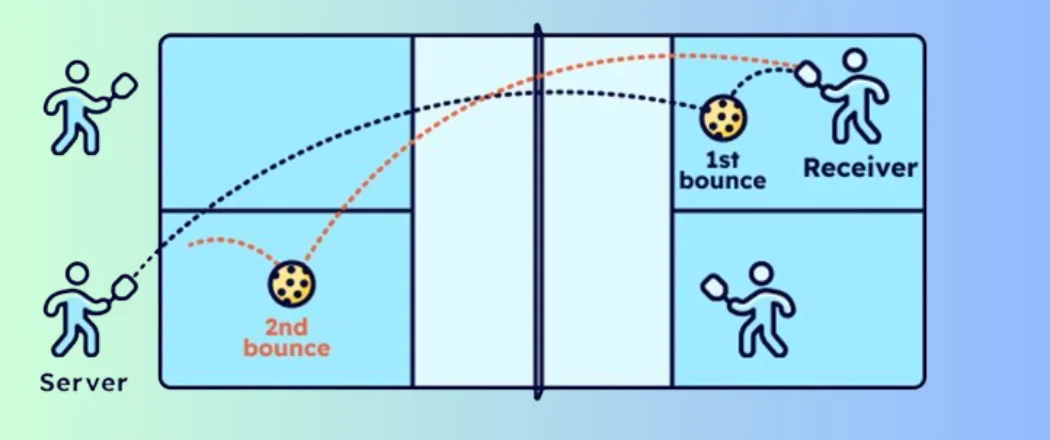
Both players on the serving doubles team can serve and score points until they commit a fault.
- The first serve of each side-out is made from the right/even court. The server switches sides and initiates the next serve from the left/odd court if a point is scored. As subsequent points are scored, the server continues switching back and forth until a fault is committed, and the first server loses the serve. When the first server loses the serve, the partner serves from their correct courtside.
- The second server continues serving until his team commits a fault and loses the serve to the opposing team. Once the service goes to the opposition (at side out), the first serve is from the right/even court, and both players on that team have the opportunity to serve and score points until their team commits two faults.
For Singles
The server serves from the right/even court when the score is even and from the left/odd when the score is odd.
Points are scored only by the serving team. Games are typically played to 11 points, win by 2.
When the ball is served, the receiving team must let it bounce before returning, and then the serving team must let it bounce before returning, thus two bounces.
Tennis Rule
Tennis pits two gladiators against each other in a singles showdown. These racquet-wielding warriors square off on opposite sides of the net, trading blows with their stringed weapons.
The skirmish ignites when one player unleashes a serve while their adversary aims to parry the attack. A valid serve must kiss the service box before the returner can strike back.
Should the server’s aim falter, resulting in a fault, they’re granted a second chance to ignite the rally – the second serve. Misfire twice, and you’re slapped with a double fault, forfeiting the point.
If a serve clips the net’s crest but still lands in the correct service box, it’s deemed a LET, prompting a do-over. Fail to return a legitimate serve, and the point goes to the server.
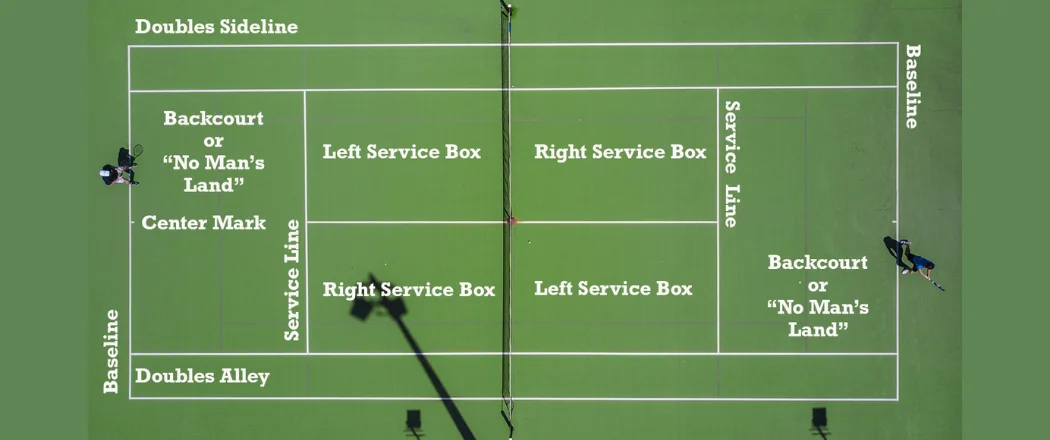
Once the ball’s in play, it’s a tactical tug-of-war. Players vie for supremacy, striving to keep the fuzzy yellow sphere within bounds while outmaneuvering their opponent. The point concludes when someone whiffs, launches the ball out of bounds, nets it, or allows a double bounce.
Should the ball graze the net mid-rally but still clear it, the battle rages on. Players must respect the net’s sanctity – touching it or trespassing onto enemy territory results in immediate point loss.
The “one-hit wonder” rule reigns supreme; multiple strikes before returning the ball are strictly verboten.
Court lines act as the thin boundary between glory and defeat. A ball kissing any part of the line is considered IN, keeping hopes alive and rallies burning.
In this high-stakes duel of reflexes and strategy, every shot, every decision can tip the scales between victory and defeat. It’s a chess match played at breakneck speed, where only the sharpest minds and quickest reflexes prevail.
So, pickleball is easier to learn than tennis. Its simpler rules and lower physical demands make it more accessible to beginners and those seeking a less strenuous sport.
2. Scoring
We can see how the differences in scoring systems contribute to each game’s unique strategies and pace.
In pickleball, games are usually played up to 11 points, and only the serving player or team has the opportunity to score. This means that the receiving team cannot score points. The game is won by the first player or team to reach 11 points, but they must have a lead of at least two points.
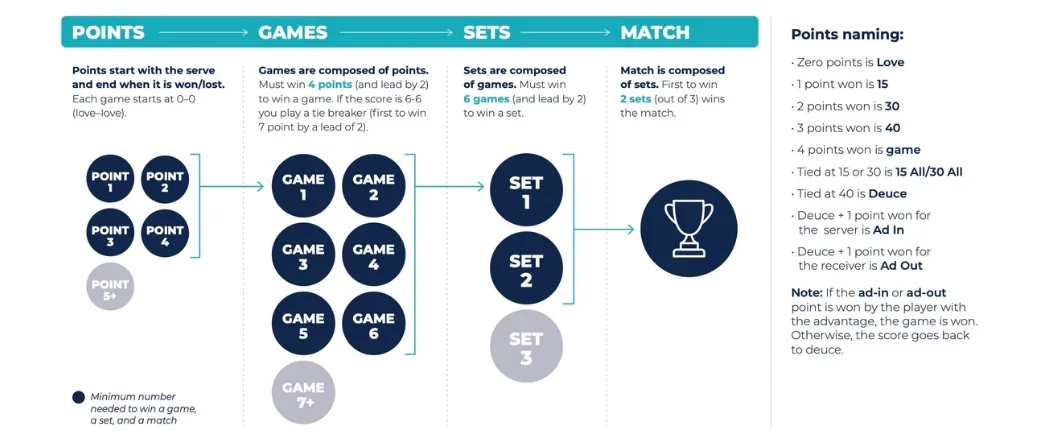
On the other hand, tennis uses a unique scoring system. The points are referred to as “15” for the first point,“30” for the second point, and “40” for the third point.
The first player to win 4 points wins the game.
However, if the score reaches 40-40, it’s called a “deuce,” and the player who scores two points after the deuce wins the game. Unlike in pickleball, in tennis, both the server and the receiver can score points.
It could be argued that Pickleball might be simpler for beginners because of its straightforward point system. In tennis, the scoring system is more complex and can take some time for new players to understand.
3. Court & Dimension
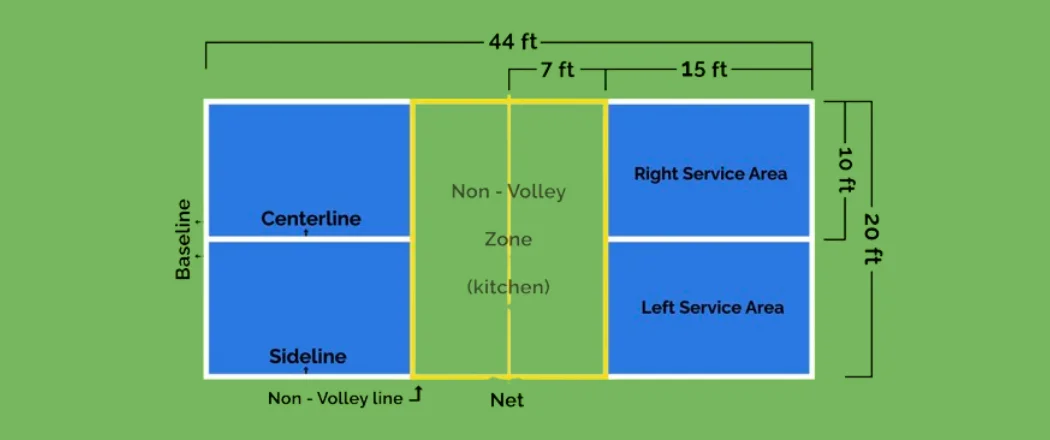
A standard pickleball court is smaller, measuring 20 feet wide by 44 feet long. This compact size makes it easier for players to cover the ground and allows for more intense rallies.
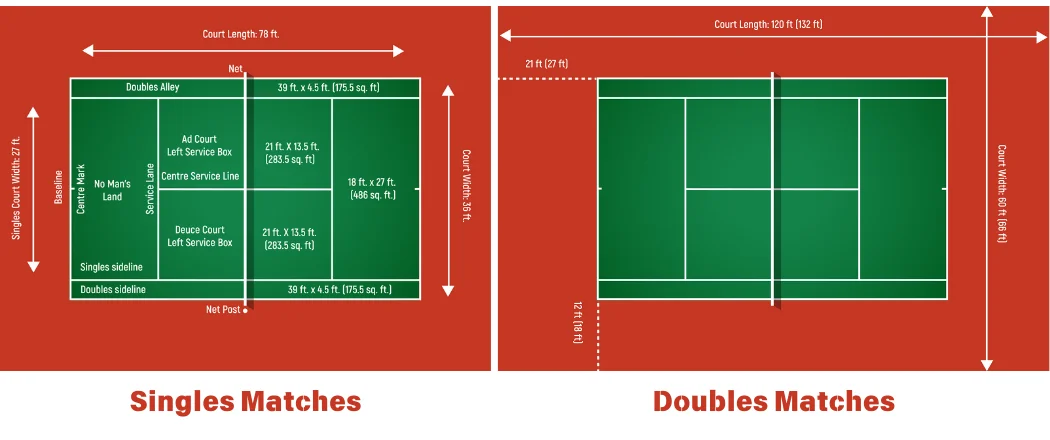
On the other hand, tennis courts are larger, measuring 78 feet in length and 36 feet in width for singles matches. For doubles matches, the court expands to 60 feet wide by 120 feet long.
The larger court size in tennis leads to a different pace of play, requiring players to cover more ground and strategize differently.
So, when we consider the court size and dimensions, pickleball might be easier to play for beginners or those who prefer less running and movement. However, tennis is also not a bad idea if you are a player who enjoys the challenge and physicality of playing on a larger court.
4. Equipment
4.1 Ball
The tennis ball is smaller than the pickleball. The size is 2.7 inches in diameter, weighing between 1.98 and 2.1 ounces. Professional players hit serves at around 120 mph, with top players like Roger Federer serving at 142 mph.
Tennis balls are made of a rubber compound covered with felt, which gives them their unique bounce and feel. The rubber core is designed to stay consistent throughout different shots, while the felt modifies the ball’s aerodynamic properties. Tennis balls do not have a way to pump them back up with air and have a limited lifespan.
Pickleballs are 2.92 inches in diameter, weighing .78 to .93 ounces. They are made of hard plastic with hollow centers and holes, similar to a wiffle ball. Outdoor pickleballs have smaller holes to minimize the impact of wind.
Pickleballs are generally made of lightweight plastic, and their durability varies depending on the type of plastic used. Some pickleballs are made of solid plastic, while others are made of a composite.
4.2 Paddle/racket
| Paddle (Pickleball) | Racket (Tennis) | |
| Form | Typically, it has a rectangular form. | Usually it has a round or oval form |
| Size | The standard size is approximately 15.5 inches long and 7.75 inches wide. Elongated paddles are also available, around 7 inches wide and 17 inches long. | The size has a maximum length of 29 inches and a maximum width of 12.5 inches. |
| Components | The core, face, handle, grip, edge guard, and butt cap. | The head, shaft, handle, grip, butt cap, and strings. |
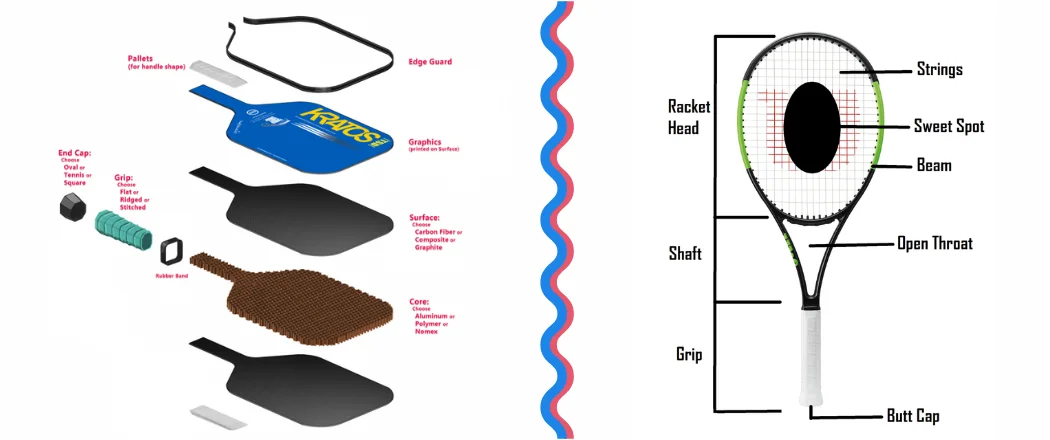
4.3 Net
For pickleball net height, the net is 36 inches tall at the posts and 34 inches at the middle point. They are typically constructed from robust materials such as braided nylon or twisted polyethylene. The lifespan of a pickleball net largely depends on the quality of the materials used and the craftsmanship of the net.
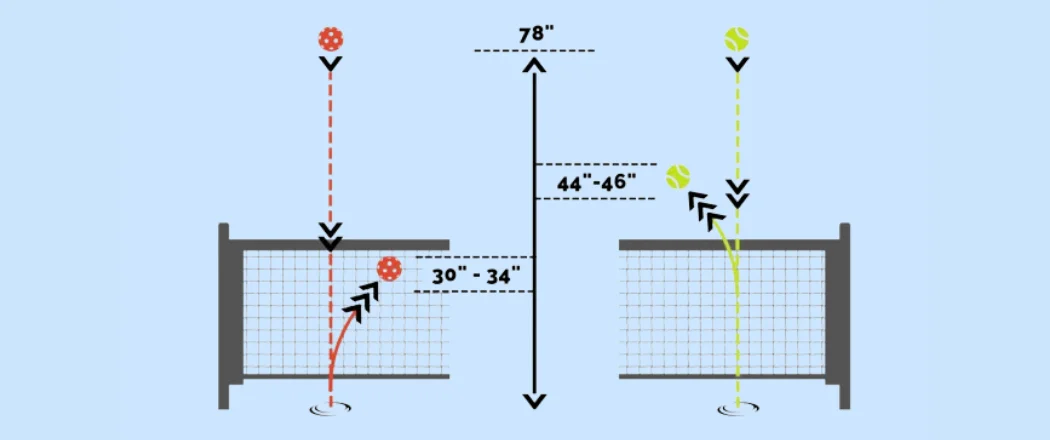
In contrast, tennis nets are set at a height of 42 inches at the posts and dip to 36 inches at the center point. This distinction means that tennis nets are generally taller and have a more pronounced dip in the middle compared to pickleball nets
They are commonly made from hard-wearing materials like nylon, polyester, or braided net cord. These materials are recognized for their strength and capacity to endure frequent use and exposure to the elements. Similar to pickleball nets, the longevity of a tennis net also hinges on the quality of the materials used and the construction of the net.
4.4 Shoes
Pickleball shoes are specifically designed to adapt to the unique demands of the sport. They are generally heavier and sturdier. It provides the necessary support for quick mobility, sudden starts and stops, and lateral movements on the court. Key features include non-skid, non-marking soles for stability, good arch support to protect your ankles, knees, and hips, and breathable mesh for comfort.
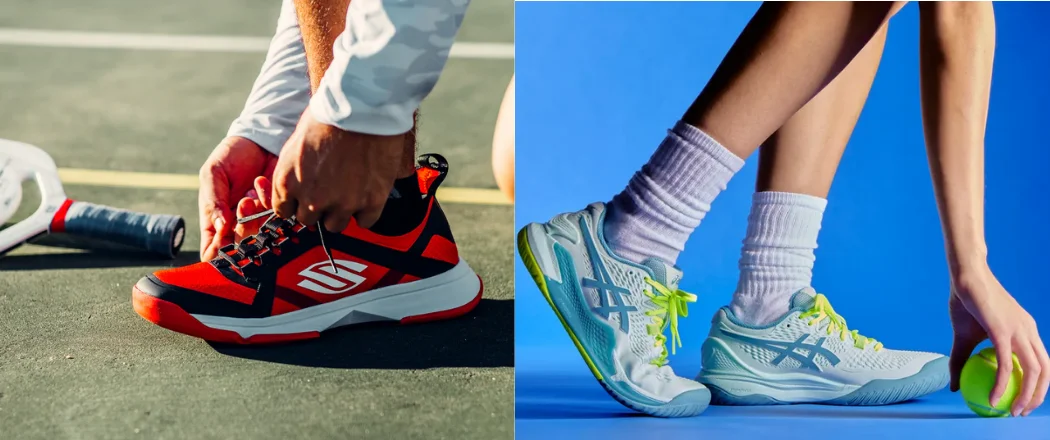
How about tennis shoes? They are designed with the needs of tennis players in mind. They are built for various movements and court surfaces, featuring rubber soles for flexibility and shock absorption, canvas or other textile uppers for breathability, and specific tread patterns depending on the court surface.
Can Tennis Shoes be Used for Pickleball?
Yes! Tennis shoes can be used for pickleball, especially on outdoor courts. It’s important to remember that they might not fully meet the specific demands of pickleball.
Tennis shoes offer versatility and adequate support, but pickleball requires better grip and lateral support. Therefore, for optimal performance and safety, it’s recommended to use shoes designed explicitly for the sport you’re playing.
5. Popularity
Despite being a younger sport, pickleball has seen significant growth in recent years, especially in the United States.
Tennis, with its long history dating back to the 12th century in France, is one of the top sports worldwide. In the latest statistics:
Tennis saw a growth of 1 million players in 2022 in the United States, with more than 23.6 million playing the sport. This represents an increase of 5.9 million people or 33 percent since the start of 2020.
In 2023, U.S. tennis participation experienced a gain of approximately 250,000 players (+1%). The gender distribution among tennis players is fairly balanced, with 47% female and 53% male.
Pickleball, on the other hand, is now the fastest-growing sport in America for the third year running. There are an estimated 48.3 million pickleball players in the United States, in accordance with the Association of Pickleball Professionals (APP) in 2023.
The pickleball paddle market size was estimated at $152.8 million in 2021 and is forecasted to grow at 7.7% CAGR through 2028.
In a nutshell, pickleball is more popular in the United States at this time!
6. Calories
Tennis and pickleball, while both being excellent forms of exercise, differ in the number of calories they burn due to the intensity and nature of each sport.
Based on exact information from the latest report:
Tennis, with its larger court size and heavier racket, is a more intense sport. A person weighing 150 lbs will burn about 422 calories per hour playing doubles tennis and approximately 573 calories per hour playing singles tennis.
On the other hand, pickleball, with its smaller court size and lighter paddle, is less intensive. A 150 lb person playing singles pickleball for 1 hour will burn about 357 calories, and they will burn about 265 calories if the same person plays doubles pickleball for an hour.
Tennis tends to burn more calories than pickleball when played for 1 hour. However, the actual number of calories burned will depend on various factors, such as the player’s weight, the intensity of the game, and whether they are playing singles or doubles.
7. Noise
The noise produced by tennis and pickleball games is primarily due to the equipment used, the size of the court, and the number of players involved.
You can be impressed by this interesting information!
Pickleball, which uses a hard plastic ball and a paddle made of wood or composite with a solid face, can produce up to 55 dB of noise. The sound is loud and high-pitched when the ball hits the paddle.
In contrast, tennis, which uses a soft rubber ball and a racket made of strings with a hollow frame, produces around 45 dB of noise. The sound is quieter, lower-pitched, and less noticeable when the ball hits the strings.
Additionally, the size of the court plays a role in noise levels. Pickleball courts are smaller, meaning players are closer to each other and the spectators, which amplifies the noise levels. While the larger size of the tennis court means that players are farther apart and have more space to absorb the sound waves. Lastly, the frequency of noise also differs.
Note that both sports are within the safe range of human hearing.
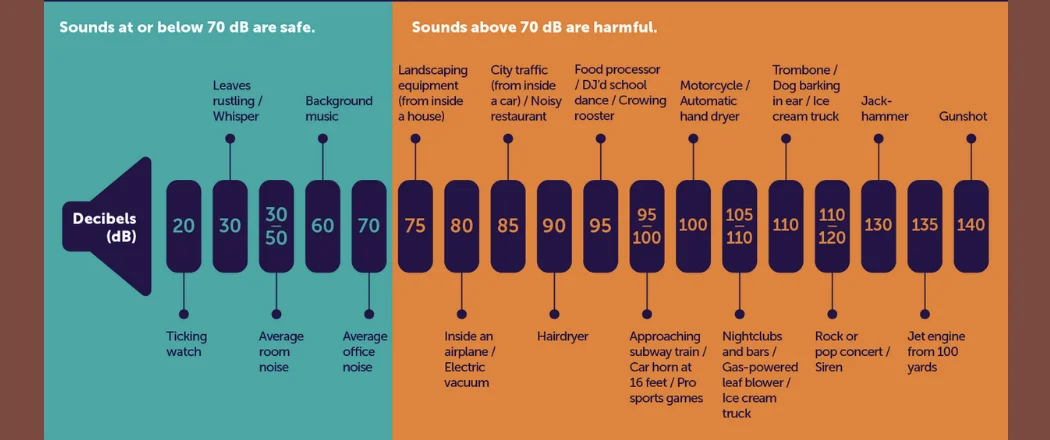
Pickleball noise is produced with a shorter time gap and higher frequency than tennis sound, which can be perceived as very annoying. Also, a pickleball strike has a higher pitch, meaning our ears catch more of its noise. Tennis might be a better choice for those who prefer a quieter environment or live in areas where noise is a concern. It’s also a good option for those who find high-frequency noise bothersome.
8. Injuries
We have gathered precise information from the National Library of Medicine to ensure the accuracy of the medical information below!
| Injury Type | Pickleball | Tennis |
|---|---|---|
| Falls | Yes | Yes |
| Calf Strains | Yes | Yes |
| Wrist Sprains | Yes | Yes |
| Lower Back Pain | No | Yes |
| Elbow injuries | Yes | Yes |
| Hip Injuries | No | Yes |
| Achilles Tendon Injuries | No | Yes |
| Joint Dysfunctions | Yes | No |
| Tendinopathies | Yes | Yes |
| Rotator Cuff Injuries | Yes | Yes |
| Foot Injuries | Yes | Yes |
| Fractures | Yes | Yes |
| Knee Injuries | Yes | Yes |
| Back Injuries | No | Yes |
However, while these injuries are common, they can often be prevented or mitigated with proper training, equipment, and technique. Always consult a healthcare professional or a trained coach to ensure you play safely.
Based on that research, tennis players are at a higher risk of shoulder injuries because of the motion of the serve and the heavier rackets. In contrast, the movements in pickleball can result in similar or potentially higher rates of knee injuries if proper precautions are not observed.
9. Difficulty
Which one is more difficult? From our perspective, the physical demands of tennis are generally higher due to the larger court and longer matches. However, tennis is more difficult than pickleball.
We gained some experience playing both of these sports! The technical skills required, such as mastering the overhand serve and powerful groundstrokes, can also be quite challenging. Additionally, tennis involves a level of tactical complexity that requires quick decision-making and strategic shot placement.
We also have advice for people who are playing tennis but want to transition to pickleball and vice versa!
- You’re moving from tennis to pickleball: First, try to get good at the underhand serve and the dink shot. A dink shot is a gentle shot that lands in the area where your opponent can’t volley. In pickleball, you need to be patient during the back-and-forth of the game. Also, where you place your shot can be more important than how hard you hit it.
- You’re going from pickleball to tennis: Tennis needs more stamina and quickness because the court is bigger. You must practice your overhand serve and get used to volleys and strong groundstrokes. The bigger court can be a good thing if you use it correctly. Make your opponent move around a lot.
Final Though
This article delves into the key differences between pickleball vs tennis, covering aspects such as rules, scoring, equipment, court dimensions and relevant information.
The main purpose is to explore which one is harder! It’s also equip you with knowledge to make informed decisions about which sport might suit you best. This information is particularly valuable given pickleball’s surging popularity and tennis’s enduring appeal. Understanding these distinctions can help prevent injuries, improve gameplay, and guide equipment choices.
From a broader perspective, this comparison showcases the evolving landscape of racquet sports. While tennis maintains its global status, pickleball’s rapid growth demonstrates the potential for new sports to emerge and thrive.
Both games offer unique benefits, contributing to a diverse sporting ecosystem that caters to various preferences and skill levels. Ultimately, even if you prefer pickleball’s strategic volleys or tennis’s powerful rallies, both sports provide opportunities for fitness, social interaction, and competitive play, enriching the world of athletics for enthusiasts of all ages and abilities.
References:
- Tennis Companion. (n.d.). Tennis Rules. Tennis Companion. https://tenniscompanion.org/tennis-rules/. Accessed on June 28, 2024.
- USA Pickleball. (n.d.). Official Rules. USA Pickleball. https://usapickleball.org/what-is-pickleball/official-rules/. Accessed on June 28, 2024.
- Britannica. (n.d.). Tennis. Encyclopedia Britannica. https://www.britannica.com/sports/tennis. Accessed on June 28, 2024.


